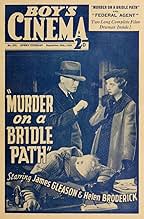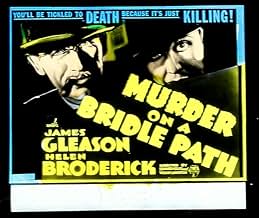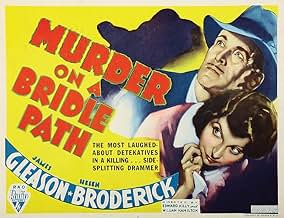Aggiungi una trama nella tua linguaAfter Hildegarde proves that the accidental riding death on a Central Park bridle path is really murder, she's faced with a plethora of red herrings and a real killer.After Hildegarde proves that the accidental riding death on a Central Park bridle path is really murder, she's faced with a plethora of red herrings and a real killer.After Hildegarde proves that the accidental riding death on a Central Park bridle path is really murder, she's faced with a plethora of red herrings and a real killer.
- Regia
- Sceneggiatura
- Star
- Taxi Driver
- (non citato nei titoli originali)
- Pipe Expert
- (non citato nei titoli originali)
Recensioni in evidenza
In this entry in the series, a pretty but difficult young woman makes enemies of everyone around her, although we're told about this more than we see it - the girl barely gets more than a scene before she is murdered while riding her horse one morning. Only the homicide investigation turns up the most likely suspect - a rich ex-husband who was a husband in the first place only because the murdered woman wanted a big payoff in the form of alimony. Piper thinks he's on to something until he learns that the man in question was in jail for non payment of alimony at the time, and that the man's only close living relative, his father, who also hates the girl for what she has done to his son, is an invalid incapable of traipsing around parks early in the morning. There are other numerous less likely suspects introduced just to keep you guessing.
As usual, Hildegarde out-sleuths Piper at several key junctures, but she also makes a key miscalculation that leads up to a big joke at her expense in the last scene, after the mystery is solved. The fact that this one word - applesauce - could ever have been considered a curse word of sorts may seem strange to modern audiences. Stranger still was that the production code was so sensitive at the time that the film had to make the retort to Hildegarde appear to have two meanings.
This one is an above average mystery and well acted, just don't expect the magic of the ones with both Gleason and Oliver starring.
But all these experiments ran out of gas, even the "Thin Man" thread. By this edition, we have a whole different set of goals, and of course a different Hildegard. This woman isn't old, imperious, thickbottomed and selfish. She's a much hipper soul and in any case she doesn't have the focus any more.
And despite there being a younger sister cast for her figure, this is all about the men. And the characters we (as guys) create. Its nothing more than that, and as big as that. (The plot revolves around an exhusband thrown in "alimony jail" because of slow payments.)
Gleason is at his most extreme, strutting with a smile. Its a smile of an actor winking at the audience, something that was passed through (in my small experience) Red Skelton, Burt Reynolds, Bruce Willis.
But the extraordinary thing and this may not be readable to some is that it is all done by acting with hats. Its an amazing experience. These are theatrical hats, a bit over-sized. All the important facial expressions have a hat equivalent or compliment.
One of the men actors is a black man playing a specific character type, a dim, stepinfetchit "boy" named Highpockets. In life, it reflects as a stereotype and is harmful because no one can deny racism. But as a character its fantastic and comes less from society directly than a long and honorable stage minstrel tradition, Watch his hat.
There are other "stereotypes," a dumb Irishman, a stilted German... but none as gracefully presented.
If the world were all hats, there would be no problems, no war, except maybe alimony.
Its set in Central Park, though not actually shot there. Too bad.
Ted's Evaluation -- 2 of 3: Has some interesting elements.
The idea to replace the perfect Withers, the arch and tightly corseted Edna May Oliver with the sophisticated, spiritually if not literally uncorseted Broderick would seem to have been grounded in the wonderful wise cracking relationship Withers had with James Gleason's much put-upon Inspector Oscar Piper, and to that extent it works.
Broderick, the beloved sophisticate of the Fred Astaire films TOP HAT and SWING TIME, gets off some good ones ("Oh, I have some influence with Inspector Piper; we used to room together in college!"), but it's hard to picture her as the prim school teacher that Palmer's Miss Withers says she is.
The film has the further drawback for some modern audiences in incorporating some of the racist stereotypes of the era in Willie "High Pockets" Best's excellent performance as the slow but steadfast stable boy who may be near the center of the mystery. In 42 films from 1934 to 1947 (just to consider the ones reviewed in the New York Times - some, like HIGH SIERRA and CABIN IN THE SKY, genuine classics), Best took the work Hollywood offered and made his characters shine - whatever limitations Hollywood may have placed on the casting of black actors.
MURDER ON A BRIDLE PATH has a good cast all around (among the series regulars, James Gleason's Piper, James Donlan's comic detective and Gustav Von Seyffertitz's police doctor are some of their best performances), and boasts an excellent mystery at the core. The OBSERVANT viewer even has an honest chance to beat Withers and Piper to the solution despite some delicious red herrings along the way.
Radio Pictures had clearly moved the series to a back burner when Oliver left (no more "name" producers and even Max Steiner's musical contributions went uncredited this time), but at least with Broderick finding the clues and lending a major hand with the comedy, the quality stayed high.
Later in the year, the studio would turn to Zasu Pitts for two final "Miss Withers" films, and while she would return the unsophisticated primness to the character and (in small doses) Pitt could be a brilliant diffident comedienne, the quality of the writing and the chemistry between Hildegarde and Oscar never regained the level it had maintained with Edna May Oliver and Helen Broderick.
It's a pity, because the franchise was one of the more enjoyable creations of the 30's when the "cozy" mystery was at its peak and every studio seemed to be trying their hand at popularizing distinctive detectives from Philo Vance and Nick & Nora Charles to Charlie Chan and Mr. Moto. Miss Withers is missed.
It's the fourth movie in the Hildegarde Withers series. This is Broderick's only performance in the lead role. She plays it like a strict school teacher. It's fine. She's no Edna May Oliver. She's not having enough fun with the role. The investigation is rather slow and static. Without Edna May, there isn't enough in this one.
The film starts with a blonde lady being disagreeable with several folks--a clear giveaway that she'll soon be murdered (it's a standard cliché in mystery films of the time). VERY soon after, she's killed while out riding her horse. Again, Calvinnme was right--this character wasn't developed enough and her death came too quickly. The police assume she died by accident but soon they notice a few clues that indicate she was NOT killed by being kicked by a horse. Around this time, Hildegarde shows up and immediately begins digging for clues. Like any murder mystery of the era, there are lots of dead ends and twists--along with a VERY florid ending involving the murderer--and it's by far the best part of the movie.
This is a pretty good mystery film. Unfortunately, the snappy dialog from Withers isn't as obvious--not just due to Broderick but because the writing is a bit less snappy. Enjoyable but that's really about all.
Lo sapevi?
- QuizAlthough this is the first and only time Helen Broderick played Hildegarde Withers in the six picture series, James Gleason played Inspector Oscar Piper in all of them.
- BlooperWhen Hildegard is looking through the telescope, the field of view follows the horse running around the track, yet she doesn't move the telescope.
- Citazioni
Hildegarde Withers: How long have you worked around here?
'High-Pockets': About three months, Ma'am... not countin' the week I was in jail.
Hildegarde Withers: What were you doing in jail?
'High-Pockets': Shootin' craps.
Hildegarde Withers: No, I mean what did they put you in jail for?
'High-Pockets': Shootin' craps.
- ConnessioniFollowed by Il signore e la signora Sherlock Holmes (1936)
I più visti
Dettagli
- Data di uscita
- Paese di origine
- Lingua
- Celebre anche come
- The Puzzle of the Briar Pipe
- Luoghi delle riprese
- Azienda produttrice
- Vedi altri crediti dell’azienda su IMDbPro
- Tempo di esecuzione1 ora 6 minuti
- Colore
- Proporzioni
- 1.37 : 1
Contribuisci a questa pagina

































